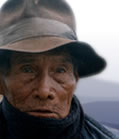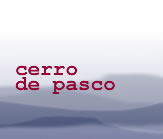THEMES IN THIS
TESTIMONY
Communications

Community Activities

Conflict

Culture and Customs

Economics

Environment

Festivals

History

Identity

Industry

Land

Livestock

Social Change

Spiritual Beliefs

Click on arrows
to find more
testimonies
featuring
these themes
|
|
Sex
|
male
|
|
|
Age
|
40s
|
|
|
Occupation
|
teacher/cultural promoter
|
|
|
Location
|
Rancas
|
|
|
Date
|
1995
|
|
summary
At least three generations of Janios' family are from Rancas and they have worked in mining and farming. He is a teacher with a strong sense of community identity and interest in preserving local traditions. He participates in community working groups, particularly in local media (TV and radio).
Janos describes in detail the rituals of many local feasts, the differences between Incan and Spanish influences, and rural and urban practices, though analysis of the role these play in people’s lives is sketchy. He refers to the rich cultural heritage of Cerro de Pasco which has benefited from migrant workers from different parts of Peru, but also stresses the way expansion of mining is destroying the purity of culture. He is proud that traditions - dances, foods, music - are preserved intact in rural areas and he wants people to value their culture, and the material heritage from the Inca period.
Mining has served the national economy and a few people, but not the local population. He discusses the 1960 uprising of the Rancas community and the ongoing disputes (over land and pollution) with the mine companies and neighbouring communities. He outlines the problems the cooperative has in improving quality and efficiency in production - it was a mistake attempting large-scale industrialisation without sufficient funds, training or local production facilties. He advocates small-scale industries using local expertise and resources, but with technical assistance from the government.
detailed breakdown
|
You will need a password from Panos to view the full
transcript of the interview. To apply for a password, click here.
Once you have a password, click here to go to the beginning
of the transcript. You can also click on any section of the
breakdown of content below and go straight to the
corresponding part of the transcript.
|
| Section 1 |
Both sets of grandparents were farmers and miners from Rancas.
Maternal grandfather (10 years in electric workshop in Cerro de Pasco Corporation) was fired along with other leaders after industrial dispute and major fire. He returned to farming and became an important leader in Rancas. Other grandfather was an independent miner and died young. His own father was a mechanic with Centromin.
Stresses strong bond with the land, farming, customs – “the campesino world” and “the Andean world”
|
| Section 2 |
Erranza (animal) fiesta (festival, celebration) at Carnival - people return from Cerro de Pasco to countryside for this. Describes the customs of each day in detail. Synthesis of Inca and Catholic customs. A table of offerings (coca, cigarettes, liquor, sweets) is prepared for the “guardian mountain”, the Jirca, to protect animals in coming year; another table for the animals. People chew coca and drink. Similar ritual throughout the Andean area.
Other feasts are purely Catholic, eg each village celebrates its patron saint: San Antonio in Rancas, three days in June. This has grown and changed – Chonguinada dance, agricultural fair, horse racing. Role of mayordomo in organising it hasn't changed.
|
| Section 3 |
Erranza celebrations are at homestead level with family and guests, so farmer is equivalent to MC. New people are brought into the celebrations by giving them an animal as a present and they are then obliged to participate and bring offerings for the next Erranza.
Explains the meaning of estancia (farmstead)
|
| Section 4 |
Community members are bound together by a common principle: all land is communal. On marriage they are allotted a farm from community land. Customs have changed, and parents no longer arrange marriages. People get married later, around 25.
Rancas had major disputes with US-owned Cerro de Pasco Corporation because they polluted the exceptionally good spring water of the Ocoroyoc area with mining waste. Under current agreement, Centromin has to return the area, after 20 years, in its original state. Uprising was over the expropriation of their land - clashed with civil guard, three community members died. Government decree has re-opened boundary issues and some conflict over land between communities.
|
| Section 5 |
Rancas was first cooperative in the region. It has grown but not enough - needs to become more productive and efficient. ECOSEM set up to create employment and develop Rancas. Has gone into heavy duty machinery and transport and wants to build a bakery and tannery. Failed wool processing industry - got credit from the government for machinery but not for rest of the process. Sufficient market but for small-scale industry. Need for technical training of young people.
|
| Section 6 |
Teaches in the Pasco sub-region but involved in the community development of Rancas. Emphasises importance of the media - now have a TV transmitter with two stations and add own youth programmes. Rancas was also a pioneer in radio in the area. They have trouble in getting a radio licence as the law favours private companies over communities.
|
| Section 6 |
Poverty in the area: mining benefits the national economy and a few small groups of people. Mining industry came to Cerro in 1902 but neither the town nor the rural areas have gained; they have failed to act at opportune moments and have lost control of their land.
|
| Section 6-7 |
Migrant workers came from all over the Andes (“they were ‘hooked into’ mining in the worst conditions with starvation wages”) and “found consolation” by settling down with local women in Cerro de Pasco, creating a new mixed culture seen in festival music and dance
|
| Section 7 |
Description of the Feast of the Cross
Chonguinada dance - mineworkers’ dance in colourful costumes to special local rhythms representing the whites (Spanish and dominant caste of land and mine owners) and rural and urban Indians. Cortamonte or Unza dance: involves felling a tree with axes, the winning couple in charge of next year's dance.
|
| Section 8 |
Briefly describes other customs: Jala Pato, Tornero de Cintas, Baile Viejo, Mama Rayhuana, Juy Juy. Some have Incan and pre-Incan roots and are warrior dances with special costumes and weapons, still performed in certain communities.
Fiesta de los Compadres (godparents of your children) – pre-Incan dance to match-make young people. Only celebrated in a couple of places, not in Cerro de Pasco
|
| Section 9 |
Customs and traditions weaken faster in the city than the country - in the city, the form constantly changes eg mixing of dances from different regions. So many migrants that few people are actually from Cerro - main influences are Huanca, Jauja and Ayacucho.
Few authentic fiestas from Cerro except the Erranza and Jaramuruy. Describes several, one is linked to the change-over of community authority; the other to the protection of fields or crops.
Chacayan is known for its retention of its Andean culture and people come back from all over the country for the fiestas.
|
| Section 10 |
Legend that the last Inca, Atahualpa, was killed by the Spanish in Cajamarca. The Carhuamayans are said to have stolen the body from the Spanish en route to Cuzco. Fiesta is celebrated in different parts of the country in the same way – he says there’s a need to recover the story behind the links between these communities.
Feels Inca remains are insufficiently valued. Customs and traditions are retained better in Yanahuanca rather than in the mining areas. Food is more traditional too, since most people in highlands don't use/buy much from other areas
|
| Section 11 |
He and his family have witnessed the change from farming to mining and they want to preserve cultural heritage. “We need to value our traditions much more and persist with our customs because this is what identifies us as peoples.”
|
|


